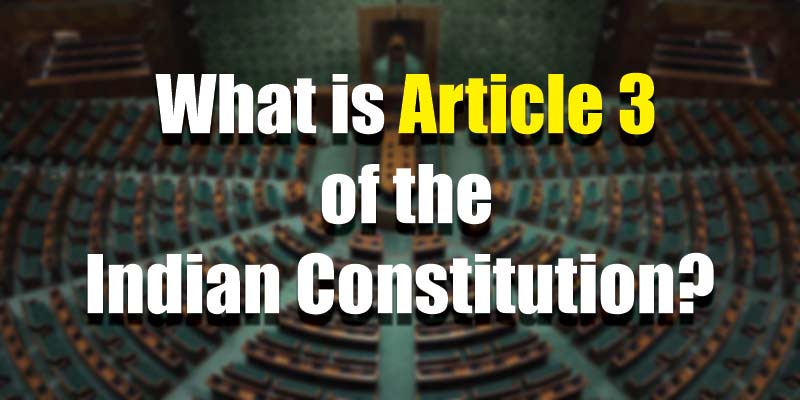- India
- Dec 12
Explainer - Article 3 and reorganisation of states
• The five-judge Constitution bench headed by Chief Justice D.Y. Chandrachud unanimously upheld the Centre’s decision to abrogate the provisions of Article 370, and directed restoration of its statehood at the earliest and holding of elections to the assembly by September 30, 2024.
• CJI Chandrachud, in his 352-page leading judgment, dealt with the challenge to the Jammu and Kashmir Reorganisation Act, 2019 under which two Union Territories — Jammu & Kashmir and Ladakh — were carved out of a full fledged state.
• The Parliament passed the Jammu & Kashmir Reorganisation Bill on August 5, 2019 that led to bifurcation of the erstwhile state.
• The pleas had challenged the Act on various grounds including that it was enacted without fulfilling the prerequisites in Article 3 which does not empower Parliament to extinguish the character of a state in its entirety.
The scope of Article 3
• Article 2 of the Constitution provides that Parliament may admit new states into the Union or establish new states.
• Article 3 deals with formation of new states and alteration of areas, boundaries or names of existing states.
• In exercise of the power under Article 3, Parliament has enacted legislations which reorganised the constituent units of the country at various points in time.
• It has altered the names of Karnataka (previously Mysore), Tamil Nadu (previously Madras), Uttarakhand (previously Uttaranchal) and Odisha (previously Orissa).
• The erstwhile state of Bombay was divided into Gujarat and Maharashtra (Bombay Reorganisation Act 1960).
• The state of Nagaland was carved out from the state of Assam (State of Nagaland Act, 1962).
• The state of Meghalaya was established, which was previously an autonomous state within the state of Assam (Assam Reorganisation (Meghalaya) Act 1969).
• The state of Haryana was carved out of the state of Punjab (Punjab Reorganisation Act 1966).
• The state of Chhattisgarh was carved out of the state of Madhya Pradesh (Madhya Pradesh Reorganisation Act, 2000).
• Sikkim was admitted into the Union of India in 1975 and was granted the status of a full state (Constitution (Thirty-sixth Amendment) Act 1975).
• Uttarakhand (previously Uttaranchal) was carved out of the state of Uttar Pradesh (Uttar Pradesh Reorganisation Act, 2000).
• Jharkhand was carved out of the state of Bihar (Bihar Reorganisation Act, 2000).
• Most recently, the state of Telangana was carved out of the state of Andhra Pradesh (Andhra Pradesh Reorganisation Act, 2014).
Power of Parliament under Article 3
• Democracy and federalism are basic features of the Constitution. The term ‘federal’ is used to indicate the division of powers between the Union government and the state governments.
• While there are certain ‘unitary’ characteristics present in the constitutional structure in terms of which the Union government has overriding powers in some situations, the existence of federal elements in the form of governments envisaged by the Constitution is a cornerstone of the polity.
• This setup has been described as quasi-federal, asymmetric federalism or cooperative federalism.
• The states neither derive their powers from the Union government nor do they depend upon the Union government to exercise their powers under the structure of the Constitution.
• Part V of the Constitution inter alia provides for the structure, functions and powers of the Union government.
• Part VI inter alia provides for the structure, functions and powers of the states.
• The SC bench said that a change in the boundaries or the name of a state does not result in the change of its character as a state, because such a character is derived not from its name or boundaries but from its relationship with the Union government – one characterised by autonomy.
• The Constitution confers legislative and executive powers on the states, which play an indispensable role in our democratic setup.
• These characteristics of states are not usually lost when its boundaries, size, or name are changed.
• States under the Indian Constitution have their own independent constitutional existence. The various organs of governance such as the state governor, the State Legislature, the High Courts, the Public Service Commissions, the state elections commissions are all creatures of the Constitution.
• The Solicitor General (for the Union of India) had submitted that statehood will be restored to Jammu & Kashmir and that its status as a Union Territory is temporary.
• In view of this submission, the Supreme Court did not find it necessary to determine whether the reorganisation of the state of Jammu & Kashmir into two Union Territories of Ladakh and Jammu & Kashmir is permissible under Article 3.
• The status of Ladakh as a Union Territory was upheld by the apex court because Article 3(a) read with Explanation I permits forming a Union Territory by separation of a territory from any state.
• However, the SC bench noted that the question of whether Parliament can extinguish the character of statehood by converting a state into one or more Union Territories in exercise of power under Article 3 is left open.
Manorama Yearbook app is now available on Google Play Store and iOS App Store

